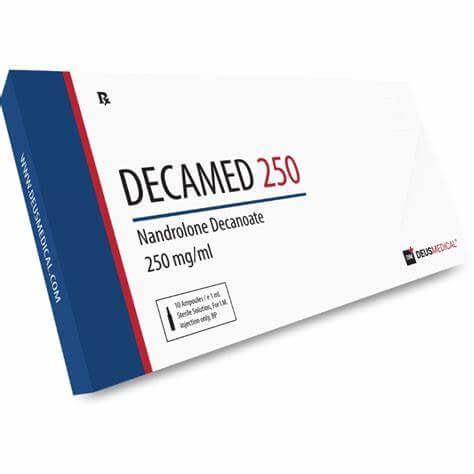A look at one of the most famous and influential steroids in history.
The History Of Nandrolone
How Deca-Durabolin changed sport forever
Nandrolone History
In many ways, nandrolone is one of the most important steroids of all time next to testosterone; it helped to pave the way for the development of exogenous steroids as we know them today and was one of the first produced for human based application within a medical / prescription based pharmaceutical capacity.
It’s widely thought that nandrolone was first released in 1960 by the company Organon owing to the fact that this was the first time the world saw the release and widespread use of nandrolone decanoate (or “deca” as it is now affectionately known) within the medical field.

Whilst this was the first time the decanoate ester variant was released, it wasn’t the first time that nandrolone was released for medical use; this initial release actually took place three years earlier in 1957 when nandrolone phenylpropionate came to fruition.
This was shortly after the initial discovery of the steroid blueprint itself (the origins of which cannot be accurately discerned.) It was again Organon who first put it to “official” use and created the first batches for distribution.
With this in mind, why is nandrolone often considered as seeing initial release in 1960 considering the first variant was available three years prior?
Whilst it was highly effective in the above capacities, where it really fell short was in regards to its administration frequency; it was simply deemed to be quite an inconvenient compound on the whole due to patients needing to take it on such a regular basis (every other day in some cases.)
As a result of the inconvenience it caused in terms of application to patients, NPP never “took off” in a commercial capacity for public use and was resigned to being somewhat of a “backroom” drug used only as a scientific and medical grade compound.
This is why this three-year window often gets omitted from the history of nandrolone – it wasn’t much of a success story until three years after its inception when it was released in a more “marketable” form. Most people in the public sector probably had no idea of its existence before then.
Organon
In 1960 Organon sought to fix this issue and make the drug appeal to a wider audience by producing nandrolone decanoate for medical use, this also made it far more practical.
This simply involved attaching the decanoate ester as a means of prolonging the drugs release into the body – for the next two years, it saw widespread medical use and scientific reports came back tremendously favourable in regards to its effectiveness. It looked like Organon had found their winning formula.
As a result of the nandrolone decanoate benefits, the company released “Deca Durabolin” in 1962 to the prescription market, and nandrolone finally reached the public sector. It was at this time that the bodybuilding community first started to experiment with it at large (it had already made its way into this sector with the initial release of NPP, but the decanoate ester lead to its widespread integration), and they particularly appreciated its low risk of side effects in conjunction with its ability to protect lean mass levels to an excellent degree.
Prior to the release of decanoate, the phenylpropionate ester had been a key focus for Organon’s marketing efforts and was cited as being one of their “flagship” products. Its production started to diminish upon the release of the latter ester however, and it ultimately took a backseat in light of the availability of this seemingly more “appropriate” compound.
Had it not been for the fact that NPP was still being used for some very specific treatment plans at the time in other countries (outside the U.S.A) it would perhaps have been abandoned completely. Other pharmaceutical companies did replicate the original NPP formula at the time (and still continue to do so although it is produced on a very minimal scale) and distribute it, but interest in this product has always been significantly diminishing since the early 1960’s.
Ever since this minimal release window got put into place, the phenylpropionate variant of nandrolone (in its “official” medical form at least) has remained very scarce and difficult to get hold of. The decanoate variant continued to “reign supreme” and enjoyed a great deal of success in both the public and medical sectors throughout the 60’s. This success continued until the 1970’s when the FDA began to revise its appropriate methods of utilisation.
They deemed that nandrolone decanoate should primarily be used only for the treatment of osteoporosis and advanced breast cancer. This greatly reduced its scope for practical use and Organon’s interest in deca waned greatly compared to their previous emphasis on this product.
Of course, whilst medical / prescription nandrolone use reduced greatly at this time, it still remained popular amongst the bodybuilding community; that popularity has never quite ceased either. It’s still as popular today as it ever was during these early years, and its unique traits make it incredibly useful for athletic application as much as aesthetic utilisation.
This is part of the reason why it got highlighted by the FDA in the late 1980’s / early 1990’s as one of the most prominent steroids being used by athletes. This was all as part of the notorious doping scandal whereas the East German athletic team got highlighted for extensive turinabol use (amongst other steroids) and a huge steroid “purge” took place, seeing many substances banned for human use all together to ensure this couldn’t happen again.
Interestingly, though deca was well known for being used in performance enhancement circles at the time – the FDA did not ban it for human use. Only for use in sport.
This is likely because it is still and always has been an incredibly useful drug for combating the narrow range of ailments it is still condoned for. This likely lead to it being shown some leniency; either that or it could be that the pharmaceutical companies producing it didn’t bow to FDA pressure and still insisted on producing it.
Regardless, many steroids weren’t so lucky and their production actually ceased completely as a result of this widespread steroid “explosion” at the time. It’s a good thing for performance and aesthetic enhancement too, because endless physiques / individuals have benefitted from the integration of deca into their cycles at everything from a novice to professional level in both bodybuilding and sports.


